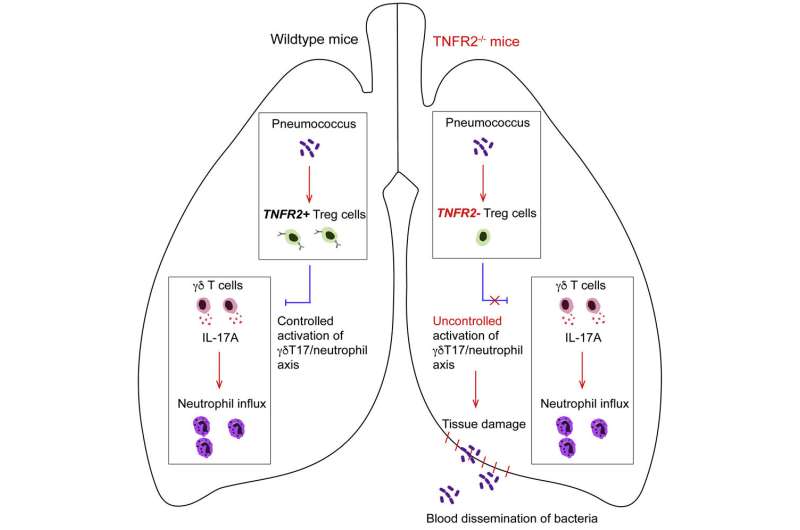This article has been reviewed according to Science X's editorial process and policies. Editors have highlighted the following attributes while ensuring the content's credibility:
fact-checked
peer-reviewed publication
trusted source
proofread
Discovery of T-cells that protect against deadly pneumococcal disease

A new study by University of Liverpool researchers reveals how resistance to bacteremic pneumonia is provided by a unique subset of lung T regulatory cells.
Streptococcus pneumoniae (the pneumococcus) is the leading cause of community acquired pneumonia with a significant proportion of cases developing bloodstream infections. Such cases of bacteremic pneumonia are associated with a high fatality rate ranging from 20% in young adults to approximately 60% in the elderly, despite the broad application of antibiotic treatment and the availability of effective vaccines. The reasons why certain individuals are more susceptible to invasive pneumococcal disease and others more resistant, has been one of the central unanswered questions of pneumococcal research for decades.
The Bacterial Pathogenesis and Immunity Group, led by Professor Aras Kadioglu at the University of Liverpool, has now discovered a subset of white blood cells in mice which confer resistance to bacteremic pneumonia. The paper is published in the journal Cell Reports.
These cells have been identified as TNFR2 expressing Tregs, and have been shown to be critical in the maintenance and control of frontline host immune responses when pneumococci infect the lungs. When these special subset of Tregs are functionally impaired or absent, the immune response to infection becomes dysregulated with excessive and uncontrolled inflammation which leads to tissue damage, allowing bacteria to spread through disrupted lung tissue barriers into the bloodstream, causing a severe and deadly condition called sepsis.
The first author of the study, Dr. Rong Xu, said, "Pneumococcal infection remains a major killer globally, despite the successful introduction of pneumococcal vaccine immunization programs. Elucidating the mechanisms of how resistance to infection may develop in high-risk groups, offers a great opportunity for us to develop targeted novel therapies."
The study lead, Professor Aras Kadioglu, said, "Our findings show that TNFR2 expressing Treg cells are absolutely essential in controlling inflammation in the lungs and preventing the translocation of pneumococci from lung to blood, thereby providing resistance to invasive disease. In susceptible hosts however, these cells are either functionally impaired or absent, which predisposes them to the development of sepsis.
"This is a significant finding, which opens the door to potential new therapies which may target and modulate these subset of Tregs to prevent and treat severe invasive pneumococcal diseases."
More information: Rong Xu et al, TNFR2+ regulatory T cells protect against bacteremic pneumococcal pneumonia by suppressing IL-17A-producing γδ T cells in the lung, Cell Reports (2023). DOI: 10.1016/j.celrep.2023.112054



















